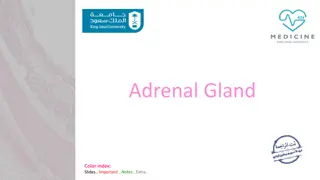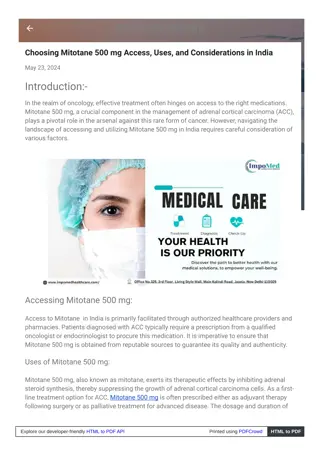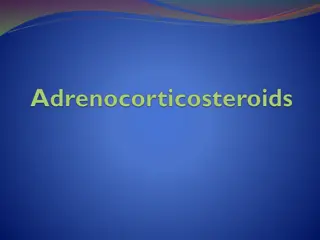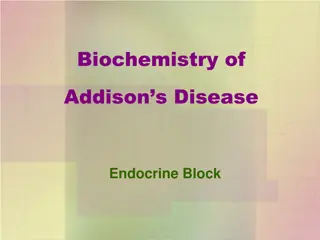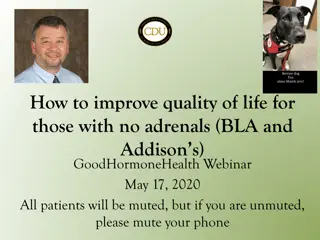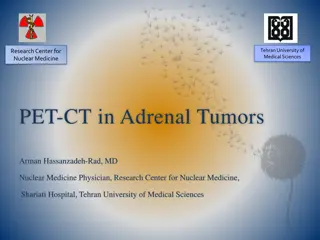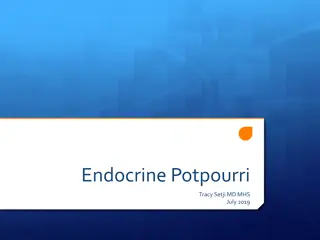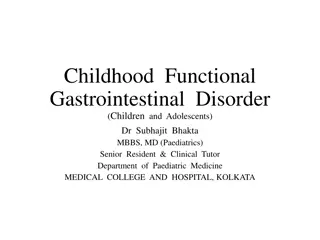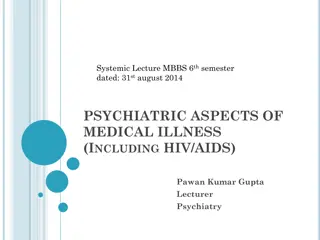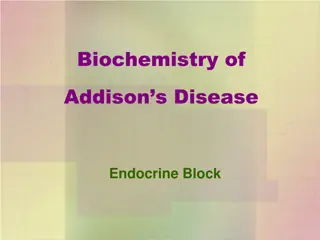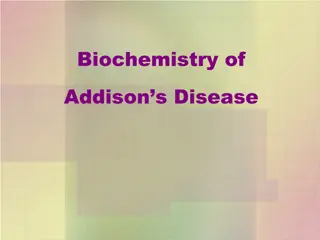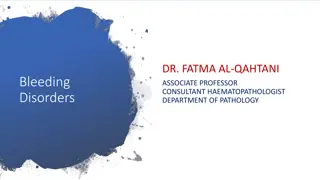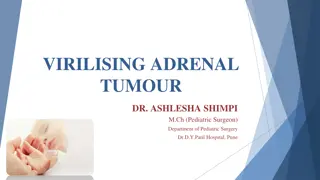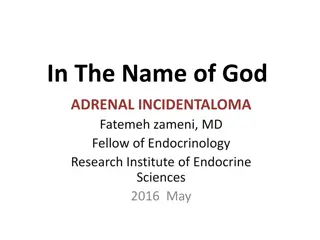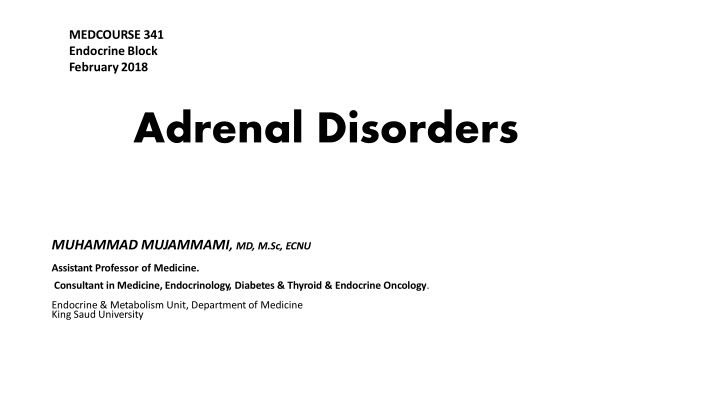
Adrenal Disorders: Anatomy, Physiology, and Management
Explore the anatomy, physiology, and biochemistry of adrenal glands while delving into the clinical approach and management of adrenal disorders such as hypersecretion and hyposecretion. Learn about the structure, function, hormones, and regulatory control of the adrenal glands, along with the evaluation and treatment of adrenal disorders.
Download Presentation

Please find below an Image/Link to download the presentation.
The content on the website is provided AS IS for your information and personal use only. It may not be sold, licensed, or shared on other websites without obtaining consent from the author. If you encounter any issues during the download, it is possible that the publisher has removed the file from their server.
You are allowed to download the files provided on this website for personal or commercial use, subject to the condition that they are used lawfully. All files are the property of their respective owners.
The content on the website is provided AS IS for your information and personal use only. It may not be sold, licensed, or shared on other websites without obtaining consent from the author.
E N D
Presentation Transcript
MEDCOURSE 341 EndocrineBlock February2018 Adrenal Disorders MUHAMMAD MUJAMMAMI, MD, M.Sc, ECNU Assistant Professor of Medicine. Consultant inMedicine,Endocrinology, Diabetes & Thyroid & Endocrine Oncology. Endocrine& Metabolism Unit, Departmentof Medicine King Saud University
Objectives Understand anatomy, physiology and biochemistry of adrenal glands Understand clinical approach and management of adrenal disorders: Function: hyper and hypo-secretion Structure
Zona Hormones Effects Regulatory Control Kidney: Maintain intravascular volume by : Increase reabsorption of Na+ and water angiotensin II, K+ Na+ Glomerulosa Salt Mineralocorticoids (aldosterone) Lipolysis Increase blood sugar ACTH Fasciculata Sweet Glucocorticoids (cortisol) Sex Androgens ACTH It is the main source of androgen in human But it is important in the disorders Reticularis Medulla Catecholamines (Epinephrine,Norepinephrine, Dopamine) Most of the time activate sympathetic fibers and increase ( BP, HR, blood sugar) But could present with activations of parasympathetic as pathologic disorders
Biochemistry All adrenal cortex hormones are originating from Cholesterol All adrenal medulla hormones are originating from amino acid Tyrosine
Adrenal Cortex Adrenal Medulla
Adrenal Disorders Function: Hypersecretion Hyposecretion Structural Adenoma Hyperplasia Bilateral vs unilateral Adrenal vs extra-adrenal Primary and Secondary
Evaluation of Adrenal disorders C: Clinical ( History and Examination) function( oversecretionorhyposecretion) Structural( headache,visualsymptoms ) B: Biochemical ScreenTest ConfirmatoryTest A: Anatomical CT or MRI adrenal ( adenoma, hyperplasia, uni or bilateral, adrenal , extradrenal, benign or malignant) Then treatment:
Physiological cortisol circadian rhythm Grossman, A. B. J Clin Endocrinol Metab 2010;95:4855-4863
Adrenal hypofunction 1. Adrenal insufficiency 2. Congenital Adrenal Hyperplasia
1- Primary adrenal insufficiency Idiopathic atrophy (autoimmune) isolated or part of polyglandulardisease (type 1 or type 2). Infection ( TB, fungal:Histoplasmosis,CMV HIV, Syphilis, ..etc) Infiltration (lymphoma, Hemochromatosis, Amyloidosis, Sarcoidosis, malignancy) Iatrogenic Surgical removal Anticoagulation and hemorrhage Medications (ketoconazole, rifampin,phenytoin, Phenobarbital, Mitotane, Metyrapone, Aminoglutethimide) Hereditary (Congenital adrenal hyperplasia,adrenal unresponsiveness to ACTH, adrenoleukodystrophy, adrenomyeloneuropathy, Refsum disease, Wolman disease) Miscellaneous: TripleA syndrome= Allgrove syndrome Adrenal hemorrhage
Secondary/Tertiary adrenal insufficiency Pan hypopituitarism (congenital / acquired): Tumors, surgery, radiation therapy Hypothalamic / pituitarydisorders Isolated ACTH deficiency Withdrawal from glucocorticoid therapy Inadequate glucocorticoid replacement Infant born to steroid-treated mother Surgical removal of ACTH-producing adenoma of the pituitary gland (Cushing's disease)
Primary adrenal insufficiency (Addison disease) destruction of adrenal cortex ( 3 layers) Dr . Thomas Addison in 1849,TB was the commonest cause. Now, autoimmune: the most common cause. Often positive adrenal antibodies Could be: an isolated problem or associated with other autoimmune diseases: Type I (APECED) : affects children:Adrenal insufficiency, hypoparathyroidism, pernicious anaemia, chronic candidiasis, chronic active hepatitis, and hair loss) Type II Schmidt's syndrome usually affects young adults : hypothyroidism, adrenal insufficiency and diabetes mellitus, vitiligo
Clinical weakness, tiredness, fatigue, Nausea, Vomiting, Constipation, Abdominal pain, Diarrhea, weight loss, Hyperpigmentation, fasting hypoglycemia. Hypotension, Shock and death Decreased axillary and pubic hair ( ? Clinical significant) NB: destruction of adrenal cortex ( 3 layers) Hyperpigmentation: only in Primary adrenal insufficiency due to melanocyte stimulating hormone (MSH) from pro-opiomelanocortin (POMC) Not ACTH
Hypotension BP and HR Standing and supine Think about AI, if not respond to IVF and initial management
B: Biochemical Primary Secondary ACTH high low cortisol low low Low High in CAH low Androgen (adrenal) Aldosterone low Normal N.B: RAS K high Normal/high Na Low Low/ normal Glucose low low Hb low Normal or low
B: Biochemical Measure am cortisol If high : R/O If very low : diagnosis If borderline result : proceed for confirmatory test ACTH stimulating test Measure ACTH to differentiate primary or secondary
A: Anatomical Adrenal insufficiency is clinical and biochemical diagnosis No indications to do imaging unless clinically indicated such as: Patient on anticoagulation Malignancy with metastasis Or other infiltrative disease
Treatment IVF: dextrose and salt for: Rehydration and to restore intravascular volume Electrolytesreplacement Steroid replacement If primary: replace both Glucocorticoids (cortisol): hydrocortisone and Mineralocorticoids (aldosterone): Fludrocortisone if secondary: replace Glucocorticoids (cortisol):hydrocortisone only NB: hydrocortisone has some Mineralocorticoids activity, so if you use hydrocortisone in high IV dose , stop Fludrocortisone
2- Congenital Adrenal Hyperplasia 90 95% of CAH cases are caused by 21- OHD Ambiguous genitalia ( Female) Failure to thrive Dehydration & Shock ( usually male) Salt-loss presentations with electrolytes imbalance: Hyponatremia Hyperkalaemia Hypoglycemia Hyperpigementation
Diagnosis Clinical: History and examination (B.P) Biochemical: Serum electrolytes & glucose: Low Na & high K Fasting hypoglycemia Elevated serum urea due to associated dehydration Elevated plasma Renin & ACTH levels Low Cortisol High 17 OHP High androgens especially testosteronelevel Low Aldosterone( in salt losing types only)
Management Hydrocortisone: 10-20 mg/m2/day divided into three doses Adult usually 10-5-5 mg Fludrocortisone 0.05 - 0.2 mg/day During adrenal crisis intravenous hydrocortisone 50-100 mg Q 6-8hrs IVF D5 0.9% saline During fever or sickness 2-3 fold increment in hydrocortisone dose In vomiting or diarrhea, parental therapy is indicated Medical Alert : bracelet
Adrenal Cortical Hyperfunction 1 Hypercortisolism : Cushing syndrome First described by Cushing in 1932 A constellation of clinical abnormalities due to chronic exposure to excesses of cortisol ACTH dependent ( pituitary or ectopic) ACTH independent (Iatrogenic ( most common), adrenal adenoma or carcinoma) 2 Hyperaldosteronism
1- Hypercortisolism rounded "moon" facies with a plethoric appearance truncal obesity with prominent supraclavicular and dorsal cervical fat pads "buffalo hump distal extremitiesand fingers are slender Muscle wasting and weakness The skin is thin and atrophic, with poor wound healing and easy bruising Purple striae may appear on the abdomen Hypertension renal calculi osteoporosis
Clinical DM, HTN, Obesity easy bruises, hirsuitism Fractures Recurrent infections Clinical features
Cushings ( excessive cortisol) C: Clinical Function: Hirsutism, acne,easilybur DM,HTN,irregularperiod,proximalweakness,recurrentinfections, depression O/E: hirsutism,acne,moonface,centralobesity, stria, proximalweakness,supraclavicularfatpad, B: Biochemical High cortisol, high ACTH (ACTH dependent) and low if (non-ACTH dependent) 24hrs forUFC 1MG DST Midnight salivary cortisol A: Anatomical if ACTH: high: MRI pituitary If ACTH: low: history then CT adrenals Treatment Surgical or Medical
2- Conn's Syndrome Primary hyperaldosteronism Adenoma, usually unilateral, of the glomerulosa cells of the adrenal cortex rarely, adrenal carcinoma Hyperplasia The clinical picture may mimic CAH from of 11 -hydroxylase deficiency Secondary HTN High Na, high Cl, high Aldosterone Alkalosis low K ( episodic weakness,Paresthesias,transient paralysis, tetany, nephropathywith polyuria and polydipsia)
Biochemical Screening test: aldosterone /renin ratio If high: do confirmatory test If low: look for secondarycauses Confirmatory test: Saline infusion test Oral salt loading test Captopril test Fludrocortisonesuppression test
Anatomical CT adrenal
Treatment Adenoma Surgical resection Adrenal hyperplasia: Spironolactone.
Pheochromocytoma Adrenal medulla: sympathetic nervous system 50% are silent. ( NO symptoms) Pheochromocytoma: Isolated or part of MEN type II A or MEN type II B Secondary HTN Episodic (spells): sweating, palpitation, headache
When you should think about Pheochrocytoma ? Typical symptoms Secondary HTN Young age < 40 3 anti-HTN medications Resistant HTN Accelerated HTN Any adrenal mass in image: adrenal incidentaloma You should R/O pheochromocytoma Cushing and if there is HTN ,you should R/O hyperaldosteronism also
Biochemical 24 hr urine collection of Metanephrines ( 2X) Plasma Metanephrines Make sure about medications that affect the result of the test (false positive )
A: anatomical CT scan = MRI MIBG: if Paraganglioma Young large size or malignant features Genetic Tests: N.B: 30-40% of Pheochrocytomaand Paraganglioma Have positive genetic test. ( not 10 % )
Management Control HTN -blocker then B-Blocker ( 10-14 days before operation) Ca-blockers: can be used Salt loading Oral NaCl: 3 days Or IVF 0.9% saline 1-2 days before surgey Surgical removal

